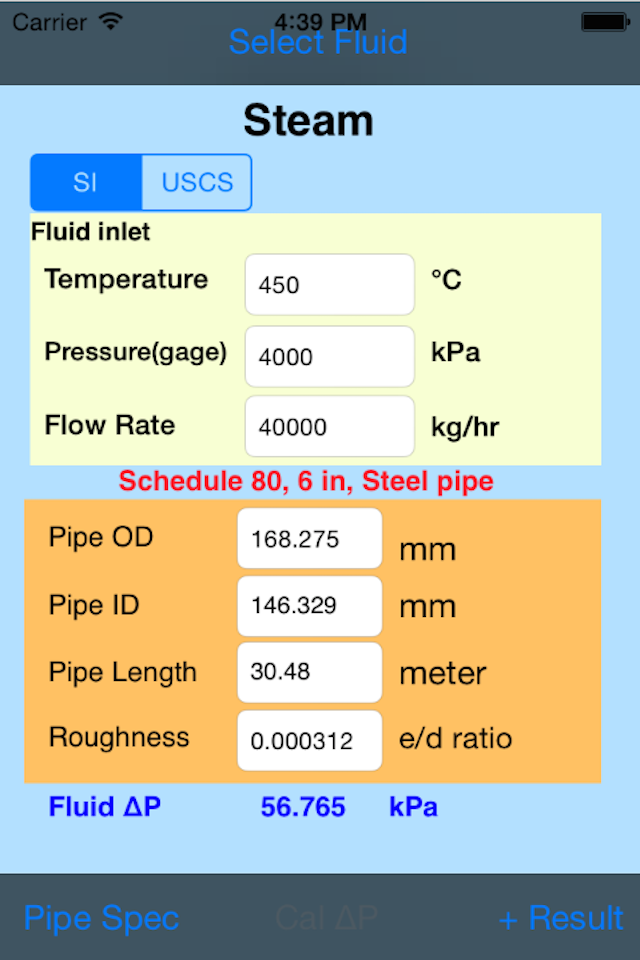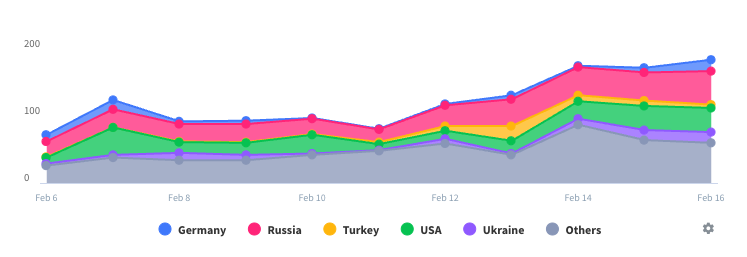
Fluid Pressure Drop
Published by: Kaup Shenoy Associates
Description
This app computes energy loss involved in transmission of fluids for industrial applications. Users can pick from a list of fifteen most common fluids, pipe schedules and sizes with different material of construction to determine overall pressure loss. A judicious selection of pipe size is often a trade off between initial cost and subsequent energy cost involved in transmission of fluid from one point to another. Therefore, the app can be a helpful tool for practicing engineers and designers in analyzing different matrix.
In addition, fluids that are not in the list, users can create a custom fluid with property data that can be saved and compute the pressure loss using the model provided in this app. Pressure loss is computed using Darcy’s equation, which gives a good estimate for both liquid and gases. For gases, the method is valid if the fluid velocity is within 40% of its sonic velocity. Also this app provides result of different flow parameters used in the computation of pressure loss.
Section has been added for computation of pressure losses in valves and fittings. Users can choose any generic valve or fitting from the list provided in this app that are commonly used in industries.
List of fluids:
Air, Steam, Water, Nitrogen, Oxygen, Hydrogen, Helium, CO2, Methane, Ethane, Chlorine, Ammonia, Argon, Hydraulic oil, HFC (R410A), Custom (user's choice gas or liquid).
Pipe Schedules:
10, 20, 30, 40, 60, 80, 100, 120, 140, 160.
Users can pick applicable sizes under nominal diameter for which app provides the corresponding inside and outside diameter.
Material of construction:
Steel, SS, GI, CI, Concrete, Copper, Aluminum, PVC, Glass, Wood, FRP, Rubber.
Based on the size, length and material of construction, the app gives the total weight of the pipe for trade-off analysis.
Valves and Fittings:
Globe valve, Gate valve, Ball valve, Butterfly valve, Angle valve, Check-valve, Check-angle, Check-lift.
Elbow, Reducer, Diffuser, T-couple, Bend-U, Bend-45, Bend-90.
Flow Parameters:
Fluid velocity, Reynolds number and pipe friction coefficient are computed as a function of pipe size, fluid density and viscosity. App has its own algorithm to compute the coefficient of pipe friction based on roughness factor for the given material and Reynolds number under turbulent conditions. For laminar flow, it is a function of Reynolds number and irrespective of pipe roughness. For more accuracy users can edit the pipe roughness factor. For gases, additional data on sonic velocity is provided for a quick reference and validity.
Unit of Measurement:
Users can choose different unit of measurement for both flow as well as pressure drop under given unit standard (SI or USCS). This can be conveniently selected while choosing the fluid from the picker list as shown in the screen shots.
Hide..
Show more..
In addition, fluids that are not in the list, users can create a custom fluid with property data that can be saved and compute the pressure loss using the model provided in this app. Pressure loss is computed using Darcy’s equation, which gives a good estimate for both liquid and gases. For gases, the method is valid if the fluid velocity is within 40% of its sonic velocity. Also this app provides result of different flow parameters used in the computation of pressure loss.
Section has been added for computation of pressure losses in valves and fittings. Users can choose any generic valve or fitting from the list provided in this app that are commonly used in industries.
List of fluids:
Air, Steam, Water, Nitrogen, Oxygen, Hydrogen, Helium, CO2, Methane, Ethane, Chlorine, Ammonia, Argon, Hydraulic oil, HFC (R410A), Custom (user's choice gas or liquid).
Pipe Schedules:
10, 20, 30, 40, 60, 80, 100, 120, 140, 160.
Users can pick applicable sizes under nominal diameter for which app provides the corresponding inside and outside diameter.
Material of construction:
Steel, SS, GI, CI, Concrete, Copper, Aluminum, PVC, Glass, Wood, FRP, Rubber.
Based on the size, length and material of construction, the app gives the total weight of the pipe for trade-off analysis.
Valves and Fittings:
Globe valve, Gate valve, Ball valve, Butterfly valve, Angle valve, Check-valve, Check-angle, Check-lift.
Elbow, Reducer, Diffuser, T-couple, Bend-U, Bend-45, Bend-90.
Flow Parameters:
Fluid velocity, Reynolds number and pipe friction coefficient are computed as a function of pipe size, fluid density and viscosity. App has its own algorithm to compute the coefficient of pipe friction based on roughness factor for the given material and Reynolds number under turbulent conditions. For laminar flow, it is a function of Reynolds number and irrespective of pipe roughness. For more accuracy users can edit the pipe roughness factor. For gases, additional data on sonic velocity is provided for a quick reference and validity.
Unit of Measurement:
Users can choose different unit of measurement for both flow as well as pressure drop under given unit standard (SI or USCS). This can be conveniently selected while choosing the fluid from the picker list as shown in the screen shots.
Screenshots

User Rating
App is not rated in Turkey yet.

Ratings History
Fluid Pressure Drop Installs
Last 30 daysFluid Pressure Drop Revenue
Last 30 daysFluid Pressure Drop Reviews
Store Rankings

Ranking History
App Ranking History not available yet

Category Rankings
App is not ranked yet
Keywords
Fluid Pressure Drop Competitors
| Name | Reviews | Recent release | |
|---|---|---|---|
|
Fluid Mechanics Calculator
97 Calculators in SI and USCS
|
0
|
1 year ago | |
|
Darcy Weisbach Equations Calc
Hydraulics Fluid Mechanics
|
0
|
8 months ago | |
|
Electric Motors Speed Calc
Motor Power Torque & Speed
|
0
|
10 months ago | |
|
Hydraulic Pressure Calculator
Hydraulic System of 2 Pistons
|
0
|
10 months ago | |
|
Heat Exchanger Area
|
0
|
2 months ago | |
|
Metal Weight Calculator ٭
Pipe,Bar,Angle,Plate,Steel etc
|
0
|
7 months ago | |
|
Pressure loss-calc.
|
0
|
2 years ago | |
|
Welding Weight Calculator Pro
|
0
|
1 year ago | |
|
Geothermal Calculator
|
0
|
1 year ago | |
|
Construction Calculator Civil
Concreate Construction
|
0
|
3 months ago |
Fluid Pressure Drop Revenue and Downloads
Gain valuable insights into Fluid Pressure Drop performance with our analytics.
Sign up now to access downloads, revenue, and more.
Sign up now to access downloads, revenue, and more.
App Info
- Category
- Utilities
- Publisher
- Kaup Shenoy Associates
- Languages
- English
- Recent version
- 2.2 (5 months ago )
- Released on
- Sep 30, 2011 (13 years ago )
- Also available in
- United States, United Kingdom, Netherlands, Pakistan, Japan, South Korea, Kuwait, Kazakhstan, Lebanon, Mexico, Malaysia, Nigeria, Norway, New Zealand, Peru, Philippines, India, Poland, Portugal, Romania, Russia, Saudi Arabia, Sweden, Singapore, Thailand, Turkey, Taiwan, Ukraine, Vietnam, South Africa, Denmark, Argentina, Austria, Australia, Azerbaijan, Belgium, Brazil, Belarus, Canada, Switzerland, Chile, China, Colombia, Czechia, Germany, Italy, Dominican Republic, Algeria, Ecuador, Egypt, Spain, Finland, France, Greece, Hong Kong, Hungary, Indonesia, Ireland, United Arab Emirates
- Last updated
- 3 weeks ago





